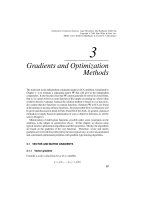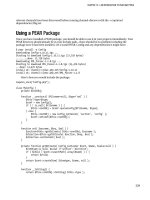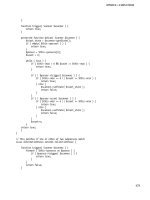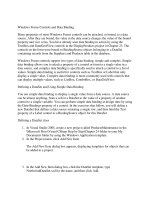Tài liệu Game Changers - Education and Information Technologies ppt
Bạn đang xem bản rút gọn của tài liệu. Xem và tải ngay bản đầy đủ của tài liệu tại đây (22.03 MB, 402 trang )
InformatIon
EducatIon and
tEchnologIEs
Edited by
diana G. oblinGer
G
ame
C
hanGers
Changers
Game
G
ame
C
hanGers
InformatIon
EducatIon and
tEchnologIEs
Edited by
diana G. oblinGer
Game Changers: Education and Information Technologies
© 2012 EDUCAUSE
This book is released under a Creative Commons Attribution-NonCommercial-NoDerivs
3.0 license ( Authors retain the
copyright to their individual contributions, which are released under the same Creative
Commons license except as noted.
For more information or for permission requests, please visit educause.edu/copyright.
This book is available in its entirety on the EDUCAUSE website, at educause.edu/books.
ISBN 978-1-933046-00-6
FROM THE EDITOR
I would like to thank the many people who made this book possible, particularly
Gregory Dobbin for managing the project and Karen Mateer for her research.
—Diana G. Oblinger
EDUCAUSE is a nonprofit association and the foremost community of IT leaders and
professionals committed to advancing higher education. EDUCAUSE programs and ser-
vices are focused on analysis, advocacy, community building, professional development,
and knowledge creation because IT plays a transformative role in higher education.
EDUCAUSE supports those who lead, manage, and use information technology through
a comprehensive range of resources and activities. educause.edu
Game Changers: Education and Information Technologies is published by EDUCAUSE,
with generous support from Ellucian.
Cover and interior design by Michael Brady Design (michaelbradydesign.com).
Game Changers: Education and Information Technologies
Today’s knowledge revolution isn’t about how much information is available. It’s
about how fast knowledge can travel through vast, connected networks of people—and
how it can grow exponentially.
Ten years ago we knew that technology would change the face of education, and
we were just beginning to imagine the ways. Today, learning can happen anywhere.
More people, with increasingly diverse needs, are seeking education, and almost every
country is promoting greater access to education. At a time when educational attain-
ment is a global priority, the need to reimagine the education experience has never
been greater.
Game Changers: Education and Information Technologies explores the tools and
processes that can improve the quality, flexibility, and scalability of postsecondary ed-
ucation. The book takes a hard look at the education landscape today and asks what
that landscape might look like tomorrow. It asks important questions and pushes us
to open our minds about how technology will shape the universe of possibility for to-
morrow’s students.
• How will your institution negotiate the new geography of learning? Technolo-
gies are reshaping how people learn and connect, and people are connecting
to a global learning network previously inconceivable.
• In a world where information is always accessible, how will teaching and
learning change? Learning is no longer bound by classrooms, libraries, or even
instructors. Online tools make resources available to learners everywhere.
Open-source learning can reach thousands of learners in nontraditional ways.
• What will constitute an institution of higher education in the future? More
and more, competencies, not credit hours, determine credentials. A degree is
no longer the only indicator of success. How we understand and assess learning
is changing. Portfolios will augment standard assessment tools.
•
How do we ready our institutions, our students, and ourselves for what higher
education can—and must—become? Many institutions are piloting innovative
models for education, and the entire community can benefit from the lessons
learned.
These are questions that we at Ellucian ask ourselves every day as we work to help
more than 2,300 colleges, universities, state systems, and foundations around the globe
thrive in today’s dynamic world. We value our collaborative and long-standing relation-
ships with EDUCAUSE and the amazing community that makes it strong. Working to-
gether, our collective intelligence will help shape the future of education.
Ellucian is proud to sponsor this book and support ongoing efforts to help higher
education meet the challenges of today and those of tomorrow.
John F. Speer III, President and CEO, Ellucian
vii
Contents
Foreword xi
Molly Corbett Broad
Game Changers
Introduction 3
Diana G. Oblinger
CHAPTER 1
The Knowledge Economy: Challenges and Opportunities for
American Higher Education 9
Paul E. Lingenfelter
CHAPTER 2
The Questions We Need to Ask
First
: Setting Priorities for Higher
Education in Our Technology-Rich World 25
Debra Humphreys
CHAPTER 3
IT as a Game Changer 37
Diana G. Oblinger
CHAPTER 4
From Metrics to Analytics, Reporting to Action: Analytics’ Role in
Changing the Learning Environment 53
Linda Baer and John Campbell
CHAPTER 5
IT Innovations and the Nontraditional Learner 67
Pamela Tate and Rebecca Klein-Collins
Game Changers: Education and IT
CHAPTER 6
Why Openness in Education? 81
David Wiley and Cable Green
CHAPTER 7
Early Days of a Growing Trend: Nonprofit/For-Profit Academic
Partnerships in Higher Education 91
Daniel Pianko and Josh Jarrett
CHAPTER 8
Scaling Up: Four Ideas to Increase College Completion 105
Vernon C. Smith
CHAPTER 9
Western Governors University 115
Robert W. Mendenhall
CHAPTER 10
University of Phoenix 133
William (Bill) Pepicello
CHAPTER 11
SUNY Empire State College: A Game Changer in Open Learning 145
Meg Benke, Alan Davis, and Nan L. Travers
CHAPTER 12
Athabasca University: Canada’s Open University 159
Dietmar Kennepohl, Cindy Ives, and Brian Stewart
CHAPTER 13
Providing Quality Higher Education for Adults 175
Susan C. Aldridge
CHAPTER 14
University of the People 187
Shai Reshef
CHAPTER 15
The Open Learning Initiative: Enacting Instruction Online 201
Ross Strader and Candace Thille
CHAPTER 16
The Postmodality Era: How “Online Learning” Is Becoming “Learning” 215
Thomas B. Cavanagh
CHAPTER 17
Going the Distance: Outsourcing Online Learning 229
Susan E. Metros and Joan Falkenberg Getman
viii
Game Changers: Education and IT
Case Studies
CASE STUDY 1
Royal Roads University: Using Synchronous Web Conferencing
to Maintain Community at a Distance 255
Mary Burgess
CASE STUDY 2
The Open Course Library of the Washington State Colleges 259
Tom Caswell
CASE STUDY 3
Austin Peay State University: Degree Compass 263
Tristan Denley
CASE STUDY 4
Yakima Valley Community College: Using Near-Real-Time Data
to Increase Student Success 269
Wilma Dulin, Sheila Delquadri, and Nicole M. Melander
CASE STUDY 5
Ball State University 275
Jo Ann Gora
CASE STUDY 6
Mozilla Open Badges 279
Erin Knight and Carla Casilli
CASE STUDY 7
STAR: Using Technology to Enhance the Academic Journey 285
Erika Lacro and Gary Rodwell
CASE STUDY 8
OpenCourseWare 291
Mary Lou Forward
CASE STUDY 9
The Open University of Hong Kong: The i-Counseling System 301
Chun Ming Leung and Eva Tsang
CASE STUDY 10
Central Piedmont Community College: Online Student Profile
Learning System 305
Clint McElroy
CASE STUDY 11
The CHANCE Program in China: Transforming Students into
“Global-Minded” Scientific Investigators and Citizens 313
Jacqueline McLaughlin
ix
Game Changers: Education and IT
CASE STUDY 12
Georgetown University: Web Conferencing—A Critical Skill for the
Connected World 321
Pablo G. Molina
CASE STUDY 13
Blended Learning and New Education Logistics in Northern Sweden 327
Anders Norberg
CASE STUDY 14
Valencia College: LifeMap and Atlas—Planning for Success 331
Joyce C. Romano and Bill White
CASE STUDY 15
The Saylor.org Model 337
Jennifer Shoop
CASE STUDY 16
Penn State World Campus: Ensuring Success, Not Just Access 343
Wayne Smutz and Craig D. Weidemann
CASE STUDY 17
Stories in Our Classrooms: A Faculty Community of Practice
as an Agent of Change 349
Beverly Bickel, William Shewbridge, and Jack Suess
CASE STUDY 18
Kansas State University: Creating a Virtual Faculty Consortium 355
Elizabeth A. Unger
CASE STUDY 19
CS50 at Harvard: “The Most Rewarding Class I Have Taken . . . Ever!” 361
Katie Vale
CASE STUDY 20
Transforming Education with Research That Makes a Difference 369
J. D. Walker, Charles D. Dziuban, and Patsy D. Moskal
CASE STUDY 21
Shaping the Path to Digital: The Indiana University eText Initiative 373
Brad Wheeler and Nik Osborne
Index 381
x
xi
AMONG THE MANY STRENGTHS OF HIGHER EDUCATION, the ones most fre-
quently mentioned are the roles played by its mission that yield value to society
and help create the future. Realistically, our institutions may place more em-
phasis on one element of higher education’s mission—research or teaching or
outreach—over another; support different types of students; and serve different
geographic areas as well as local, regional, or national constituencies. And some
focus on the liberal arts, others on sciences and engineering. The strength of
American higher education is found in this rich diversity.
Over time, the diversification within higher education has expanded with
the creation of new types of institutions such as land-grant universities and
community colleges. In recent years, physical campuses have been increasingly
augmented by online offerings. The majority of today’s students may be la-
beled as “nontraditional,” with no single definition of what that term indicates.
Some are adults who have not graduated from high school. Others seek an
education but lack confidence and do not have the required foundational skills
in English and/or mathematics. Some have no clear path to or through their
education. However, the numbers are clear. No matter how well we do today,
we must serve more of all types of students—and serve them more effective-
ly—if we are to reach our national goals for education.
This book helps those in higher education explore important questions
through ideas that we might incorporate as we prepare for the next genera-
tions of students. While we honor our history—remembering that much of the
power of higher education is in its tradition of critical inquiry—we must not
shy away from questioning some time-honored practices and previously held
assumptions. Let us consider:
Foreword
© 2012 Molly Corbett Broad
Game Changers: Education and IT
•
Cognitive science and recent research about the human brain are giving
us new insights into how students learn. Can we ensure our education-
al system is flexible, incorporates new approaches in line with the way
we learn, and adapts its organizational structures to the needs of the
learner rather than constraining the learner’s options?
• What new models currently exist and what models can we create that
better serve our students as individual learners as well as society as a
whole? And can we celebrate the creation of new models that serve
unique needs without having qualms about the differences?
• Today we have tools that were virtually unknown a few years ago.
Which of these are most promising in the digital world our institutions
helped produce? Given these tools, are there foundational competen-
cies that can be mastered through multiple means?
• What can we learn from disruptive change in other sectors? Do we
have the leadership that pushes us to think and act differently to
achieve our goals?
• If we were to reset or reinvent higher education for the future, what
would we continue, discontinue, or change?
The needs of our society are clear. Quality education, broadly available,
is an imperative. It is not enough to open the doors to more learners—we
must do more to help them achieve the education and preparation they seek
and that today’s world demands. Currently, our aspirations are greater than
our accomplishments. We must ensure we are not overlooking options from
which we have previously turned away or that we failed to explore. Higher
education fosters creative insights and innovative questioning, and the contrib-
utors to this book offer a range of models and a wealth of examples to help
us think outside our comfort zone. These models can serve as a starting point
for exploring game changers that will strengthen the learning experience for
students and the institutions of higher education that serve them, ultimately
enriching our society.
We are justifiably proud of our unique and diverse system of higher ed-
ucation. We must also have the humility to know that it can be even better.
The game changer we need may depend on how well we expand access and
improve attainment through the intelligent use of information technology to
enhance learning. Many are looking to our colleges and universities for the
answers; their future is up to us.
Molly Corbett Broad
xii
Changers
Game
3
© 2012 Diana G. Oblinger
T
HIS BOOK IS DEDICATED TO EDUCATION
. We need more education, deeper ed-
ucation, more effective education, more access to education, and more afford-
able education. While education works well for millions of learners, it doesn’t
work for everyone. There are millions more whose lives could be transformed
by education. For education to do better we cannot just keep doing the same
things. This book is also dedicated to finding the game changers that will help
us move education to the next level, whether those game changers are infor-
mation technology, new models, or institutional vision.
Education is complex. Each learner’s needs, preparation, personal circum-
stances, and aspirations are different. Learning is an interaction involving the
learner and content, instructors, other learners, systems, and the environment.
Learners must play an active, informed role in their education. And their expe-
rience is made up of thousands of interactions associated with courses, student
services, administrative functions, technology, and people.
Learners encounter roadblocks. Some aren’t prepared for college-level
work. Many don’t have strong study or personal skills. Others have financial
challenges. Competing demands from family and work can distract. Some ar-
en’t well suited for the major they chose, and many don’t know what courses
to choose to graduate on time.
Educational institutions have their own roadblocks. Escalating costs.
Decreased funding. Rising demand. Increased oversight and regulation. En-
trenched practices. Dated models. Constraining policies.
If education is a game changer, what are the game changers for educa-
tion? This book presents some of those game changers.
How one conceptualizes the educational experience can be a game chang-
er. Institutions such as Western Governors University, Empire State University,
Introduction
Diana G. Oblinger
Game Changers: Education and IT
4
University of Maryland University College, Athabasca University, and Univer-
sity of the People began with unique ideas about how education might be
structured, delivered, and assessed.
Information technology is a game changer. It can deliver content instant-
ly, bring distant individuals together, and make administrative processes faster.
But IT can be more than a delivery channel. IT can change the educational ex-
perience through simulations, games, haptic devices that allow users to “feel,”
augmented reality, and more.
But to really change the game, IT must be used differently. Because of IT
we can collect data on individual interactions and use that information to pre-
dict who is at risk of failing, tailoring interventions to their needs. That same
data can be used to create recommendation engines, reminiscent of Amazon
or Netflix, that help students select the best courses for their skill level and
needs or plan a more efficient pathway to their degree. IT allows people from
around the world to collaborate, learning from each other and creating more
than any one person could individually.
The book begins with some fundamental questions we must ask about ed-
ucation. Beyond describing the challenges of funding, demographics, and the
demand for education, educators must ask what we need to do and how we
know if we’ve been successful. Lingenfelter describes many of the challenges of
the current environment, including cost, productivity, quality, and how to more
seamlessly integrate K–12 and higher education. Humphreys challenges us to
first set the priorities for higher education before then looking to technology
and other solutions for a means to reach those goals.
A number of game changers are described, including information technol-
ogy, openness, analytics, assessment, and public-private partnerships. The most
important drivers of innovation are the models that harness the power of IT to
deliver educational value. Beyond delivering information, IT can power recom-
mendation engines, co-creation, and analytics and enable the unbundling and
rebundling of traditional processes. As Wiley and Green illustrate, openness is
a philosophy, as well as a model for innovation and business. Through sharing,
remixing, and repurposing, value can be created and captured, whether the
focus is content or new ideas. Analytics (trend analysis, forecasting, prediction,
optimization) allows educators to identify at-risk students and intervene, im-
proving the chances for student success. Analytics is used for course improve-
ment, as well. Baer and Campbell also suggest future directions for analytics.
Adult learners bring their own special circumstances, such as the need for rec-
ognition of prior learning. Tate and Klein-Collins describe a variety of systems
(e.g., prior-learning assessments) that, although designed for adult learners, are
broadly applicable. Describing an approach that may allow more institutions
Introduction
5
to expand into online and specialized programs, Pianko and Jarrett highlight
the growth of public-private partnerships. Smith explores potential models that
combine the use of IT and alternate models for course completion and creden-
tialing, providing the potential for greatly reduced costs.
There are multiple examples of institutions that have taken alternative
approaches: Western Governors University, the University of Phoenix, Empire
State College, Athabasca University, and University of the People. Each insti-
tution employs unique combinations of IT, openness, analytics, and student
engagement to achieve its goals. Using analytics to drive student achievement,
course improvement, and cognitive science is exemplified by Carnegie Mellon
University’s Open Learning Initiative. Cavanagh describes the use of blended
learning and research to create a postmodality era—instruction is no longer
face-to-face or online, it exists wherever you want it, having moved past tra-
ditional modes. Public-private partnerships are allowing institutions such as
the University of Southern California to leverage their expertise and grow pro-
grams that were designed digital.
The chapters alone cannot illustrate all the innovative approaches using in-
formation technology that might change the game for education. In the book’s
final section, over twenty case studies provide a wealth of examples of how
institutions are improving education with information technology. The case
studies span the globe and address new learning environments, approaches
to sharing open content, recommendation systems that help students improve
course success and reduce time to degree, how IT is enhancing “traditional”
courses, and alternative credentialing systems. The cases also describe how re-
search and analytics can drive and support change. Multiple themes are high-
lighted by these case studies.
•
Changing the learning experience: Time, convenience, and integra-
tion of information can change the educational experience. Institutions
such as Ball State University, University of Maryland Baltimore Coun-
ty, and Georgetown University are consciously using IT to change the
learning experience, making it more immersive. CS50 at Harvard and
Penn State’s CHANCE program use technology to enhance tradition-
al environments, resulting in motivating and highly effective learning
experiences.
•
Guiding and personalizing: IT allows students to get the information
they need to make better decisions, such as about course selections,
transfer options, and degree programs. Helping students make better
choices are the goals of the University of Hawaii’s STAR program and
the University of Hong Kong’s iCounseling system. IT can recognize
Game Changers: Education and IT
6
patterns and match individuals with the courses and program that best
suit them. Austin Peay State University’s Degree Compass personal rec-
ommendation system represents a new era in personalization, which
is particularly important for at-risk students. Valencia College created
LifeMap and is now extending the student-support system to other in-
stitutions. Central Piedmont Community College’s Online Student Pro-
file (OSP) system helps ensure that students are successful and is also
being adopted by six other institutions.
•
Learner-centered design: Many case studies illustrate how the learn-
er is at the center of a program’s design, such as the Olin College
of Engineering and Penn State’s World Campus. Norberg describes a
blended model in Norway that was designed to meet the needs of stu-
dents in rural areas. When Royal Roads University began “rethinking
residencies,” they created virtual-experience laboratories as an alterna-
tive to face-to-face residencies. Recognizing that not all students have
the same needs is critical.
•
Research: Research on students and on what works drives innovation
and adoption. Walker and his colleagues describe the research pro-
grams that support educational innovation at the University of Min-
nesota and the University of Central Florida. Dulin, Delquadri, and
Melander illustrate the essential role of research with the Achieving the
Dream reform network and Yakima Valley Community College’s Office
of Institutional Effectiveness.
• Open solutions: Open educational resources are inherently scalable
because they can be reused, remixed, and repurposed. The Open-
CourseWare Consortium, the Saylor Foundation’s open college course-
ware, and the Washington State Board for Community and Technical
Colleges’ Open Course Library are examples. And, Mozilla’s Open
Badges project, in an effort to leverage open educational resources and
find a more flexible model for credentialing, provides an alternative to
traditional models.
• Scaling: Scaling may hinge on moving beyond a not-invented-here
mind-set to one that values sharing, allowing institutions to reach more
learners and use resources more efficiently. Indiana University’s eTexts
program is saving students 40 percent or more on textbook costs by
aggregating demand and negotiating reduced costs of electronic re-
sources. The Great Plains Interactive Distance Education Alliance is a
virtual faculty consortium that allows institutions to more agilely re-
spond to changing educational needs, offering degrees and certificates.
Introduction
7
Colleges and universities are complex adaptive systems where people and
technology can work together to create value. The college or university learn-
ing experience is more than “the classroom.” For institutions to make the best
use of technology to address educational needs, they must understand the
learner and design the desired experiences, taking into account the many so-
cial, technical, and intellectual interactions among students, faculty, and staff;
the organization; and the infrastructure.
Institutions must design processes and experiences that will allow students
to solve their problems and achieve their goals, as well as create long-term ed-
ucational value both for students and society. However, multiple models will
be required, because student readiness, needs, aspirations, and circumstances
vary. If students are unprepared, institutions must ask what services and expe-
riences could better prepare them. If students are fully prepared, institutions
can still create new and innovative ways to add even greater value to their
educational experience.
Much of the use of information technology to date has focused on con-
tent delivery that emphasizes information or course management systems
rather than on student support or collaborative, interactive, and immersive
learning environments. The educators represented in this book are innovating
as individuals, programs, and institutions. They are focused on student needs
and are designing alternative models that allow students to achieve more of
their potential.
Education is a game changer. We owe it to ourselves, our students, and
our society to keep working to change education for the better.
Diana Oblinger is President and CEO of EDUCAUSE. She is known for launching in-
novative initiatives, such as the EDUCAUSE Learning Initiative (ELI) and the Next Gen-
eration Learning Challenges. Previously, she held positions at the University of North
Carolina system, University of Missouri, Michigan State University, IBM, and Microsoft.
Oblinger has authored and edited numerous books and publications, including the
award-winning What Business Wants from Higher Education.
9
© 2012 Paul E. Lingenfelter
THE LATE PETER DRUCKER apparently first used the phrase “the knowledge econ-
omy” in his 1969 book The Age of Discontinuity.
1
Thirty-two years later, still
going strong, Drucker wrote in the November 2001 edition of The Economist:
The next society will be a knowledge society. Knowledge will be its
key resource, and knowledge workers will be the dominant group in
its workforce. Its three main characteristics will be:
•
Borderlessness, because knowledge travels even more effortless-
ly than money.
• Upward mobility, available to everyone through easily acquired
formal education.
• The potential for failure as well as success. Anyone can acquire
the “means of production,” i.e., the knowledge required for the
job, but not everyone can win.
2
By the time Drucker wrote those words in 2001, a great deal of evidence
had accumulated to confirm his earlier foresight. Four years later, in 2005,
Tom Friedman in The World Is Flat essentially announced that Drucker’s “next
society” has arrived. Friedman argued that the following events and innova-
tions have rapidly and dramatically redistributed economic advantage around
the globe:
1. Fall of Berlin Wall (November 9, 1989)
2.
Netscape—first mainstream web browser goes public (August 8, 1995)
3. Workflow software—standardized applications, PayPal, eBay, et al.
4. Open-sourcing—Adobe Acrobat Readers, Linux
5. Outsourcing—Y2K, spin-off functions to India
6. Offshoring—China in the World Trade Organization (WTO), capital
flows to find cheap labor
1
The Knowledge Economy:
Challenges and Opportunities for
American Higher Education
Paul E. Lingenfelter
Game Changers: Education and IT
10
7. Supply-chaining—Wal-Mart retailer to manufacturers
8. Insourcing—UPS services linked to shipping
9. In-forming—“Google-like” intelligent searches and data mining
10. “The Steroids”—wireless mobile digital communication
3
As I write, popular uprisings in the Middle East are the latest example
of the political and economic implications of these forces. While events (and
especially the pace of change) are frequently surprising, it is not difficult to
speculate about the future implications of the knowledge economy for higher
education. In this chapter I will focus on four issues and discuss their implica-
tions for IT professionals. The issues are as follows:
•
Higher education must become less of an elite enterprise; a much larg-
er fraction of the world population will need higher education. Ev-
erybody will not need or achieve a four-year degree, but many more
people must be educated to a higher standard than previously required.
Achieving this goal will require both more effective education of disad-
vantaged groups and social policies to enable them to pay the costs of
higher learning. Moreover, people are likely to obtain higher education
throughout life, both as an economic necessity and as a “consumer
good.” Many young people are likely to make the transition from ado-
lescence to adulthood in “brick and mortar” colleges and universities,
but this will not be the end of their higher education.
• Higher education in the United States will continue to be a high social
and political priority, but the economic stress of an aging population,
health-care costs, growing deficits, and resistance to tax increases will
require colleges and universities to increase productivity substantial-
ly in order to meet national goals. Achieving productivity gains while
enhancing quality is the most significant challenge facing higher edu-
cation. IT is a critically important resource for meeting this challenge.
• The diversity of knowledge providers and delivery systems requires
reengineered postsecondary systems to assure quality and promote
improvement. More transparent and clear definitions of degree qualifi-
cations and new approaches to accreditation and the assessment and
certification of learning are needed.
• The growing importance of educational attainment will require more
robust relationships between elementary, secondary, and postsecondary
education. Stronger, more meaningful P–20 relationships in standards,
professional development, and data systems are essential.
The Knowledge Economy
11
The Imperative for “Mass” Higher Education
When discussing the growing demand for postsecondary education I’ve
frequently heard, “Everybody doesn’t need to go to college.” Charles Murray,
in his 2008 book Real Education,
4
elaborated this caution at length, but with
a fundamentally tautological argument. Murray maintains that a college ed-
ucation is “real” only when it results in the knowledge and skill traditionally
achieved by the most intellectually gifted people who also have enjoyed ex-
traordinary opportunities to develop their talents. If “real education” is defined
in elitist terms, quite naturally only a few people will attain it.
One doesn’t have to believe everybody can become Shakespeare or Ein-
stein to realize that Murray’s definition of “real education” is far too narrow for
the twenty-first century. All people must have more knowledge and skill in a
knowledge economy. Moreover, while wisdom and education are far from per-
fectly correlated, wisdom requires knowledge. Better-educated citizens are es-
sential for the world to cope with the political and environmental issues of our
era. Nothing in history or current experience suggests we have exhausted the
capacity of human beings to learn or their need to benefit from more learning.
H. G. Wells’s 1919 summation “Human history becomes more and more a race
between education and catastrophe”
5
is even more pertinent today.
The facts in the labor market also contradict Murray. Many who deny the
growing need for postsecondary education seem to be recalling the workforce
of the 1960s and 1970s. Even though many countries have erased the advan-
tages previously enjoyed by the United States workforce, the educational at-
tainment of U.S. workers has grown dramatically. In 1973 it had a labor force
of 91 million. High school dropouts held 32 percent of those jobs, and high
school graduates held 40 percent. Workers with no college education account
-
ed for 65.5 million jobs in the 91-million workforce. The other 25.5 million
jobs (28 percent of the total) were held by college graduates (16 percent) and
people with some college (12 percent). See Figure 1.
In 2009, the United States had a labor force of 155 million employees.
Only 14 percent of those jobs were held by high school dropouts, and 31 per-
cent were held by high school graduates. Their share of the workforce dropped
from 72 percent to 45 percent in 36 years. Workers with no college held 69.8
million jobs in 2009.
By comparison, the number of jobs held by people with college degrees or
some college jumped from 25.5 million in 1973 to 85.3 million in 2009. Post-
secondary trained workers now account for 55 percent of employees. Nearly all
the job growth in the past thirty-six years has been in jobs filled by people with
some postsecondary education.
6
Anthony Carnevale and his colleagues project









